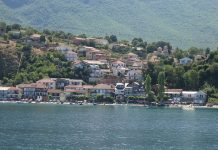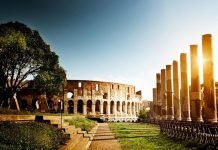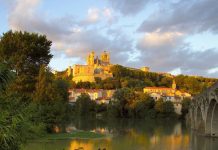Ayia Napa is a resort town which is located on the south eastern coast of Cyprus. Recently it has become well known for its great nightlife but it is still an excellent destination for a family vacation.
The name of this town derives from a monastery of the same name which can be found in the centre of the city, near to a square that houses numerous night clubs. The translation of the name Ayia Napa is “holy wooded valley” since the region was surrounded by a thick forest at the time of its founding.
History of the Region
The original monastery in the area was built in 1500 around a cave, in honour of the Christian Virgin Mary. The monastery was built as a result of a miraculous appearance of the Virgin Mary to a hunter that entered the cave. The hunter followed his dog into the cave while chasing a hare. When the hunter entered the cave he discovered a Virgin Mary icon that was illuminated in a miraculous manner. The news of this icon spread rapidly to the villages surrounding the area, and the cave was made into a shrine by Orthodox Christians, and a monastery was built surrounding the cave.
No one lived within this vicinity until about 1790, when it was settled by twenty Greeks.
Geography of the Region
Ayia Napa is situated near Cape Greco on the eastern end of Cyprus and it lies just to the south of Famagusta. Ayia Napa is part of a larger region that is called Kokkinochoria. Ayia Napa is part of the Famagusta District in the portion of the district that was not occupied by the Turks in 1974. Ayia Napa is five miles from Protaras, a low-key town that is favoured by families and locals.
Ayia Napa Tourism
Ayia Napa attracts numerous tourists, from Russian, U.K., Norway, Sweden, and Lebanon, and it has several beaches with waters sports, like windsurfing, scuba diving, water-skiing, and boating. The beaches are supervised and maintained by the Organization for Cyprus Tourism. The beach which is most popular is Nissi beach, and it is frequented primarily by young people in the summer. Harbour beach is another popular beach and it is also called Panthou or Limanaki beach. Harbour Beach is the longest beach in Ayia Napa and it caters primarily to families. A beach that is less crowded is New Golden Bay, known as Landa beach to locals and also has numerous activities. All of the Ayia Napa beaches have received the blue flag awarded by the EU for their high level of cleanliness and superior facilities. Beach parties are a very popular type of entertainment in Ayia Napa.
In the centre of Ayia Napa is The Square. The Square is full of night clubs, restaurants, and shops. For example, Club Sin, Nikita’s Steak House, and The Castle Club. Ayia Napa has been transformed in recent years and it is now a multicultural town that caters to varying tastes.
Cape Greco is within ten minutes from the centre of Ayia Napa and it is considered one of Cyprus’ most beautiful locations offering cliff jumping, sightseeing, fishing, cycling and other activities.
Shopping In Ayia Napa
The Island of Cyprus is well known for its boutiques and handicrafts. You will find these shops co-mingled with stores selling watches and designer sunglasses.
Ayia Napa Monastery
This monastery is the most famous landmark in the area. It possesses a charm that represents a bygone era when Ayia Napa was a quiet fishing village. In ancient times, the location of the monastery and the surrounding area was thickly forested and visited solely by hunters in surrounding towns.
Museums
Ayia Napa contains several museums. The Tornaritis-Pierides Museum is famous for its marine life and was founded in 1992. It is located in the Town hall on the lower level. Present and past marine life are exhibited and classified scientifically. The primary purpose is to display the marine life of the Mediterranean and Cyprus, and assist in researching the natural history of the region and in preserving environmental preservation.
Thalassa, which is a municipal museum in Ayia Napa, is dedicated to the preservation and promotion of the Cypriot marine heritage, from ancient times until the present. This museum is located in the centre of town and it displays artefacts and offers educational programs and cultural events. This museum contains engravings, sculptures, paintings, ceramics and seascapes that were created by famous Cypriot and Greek artists over the past three centuries.
Festival
The Festival of Ayia Napa originated in 1985 in September, and it has been an annual event ever since. It normally occurs during the last September weekend. The setting is the Sepheris Square in the monastery. The festivities are created in order to reflect the culture, history, and traditions of Cyprus and Ayia Napa. There are operas, theatrical performances, Cypriot folk dancing, and concerts.
Water world Water Park
Water world Waterpark of Ayia Napa is the largest European waterpark. This park has garnered international recognition for innovation and marketing from a wide spectrum of waterpark associations worldwide. This is a Greek-themed waterpark and there are extensive areas for parents to relax and playground areas for children. There is also a gift shop and a number of catering facilities. Water world is open every day of the week.
Youth Festival of Ayia Napa
This youth festival was first established in 2010 when the local youth council decided to organize a large music festival similar to those in Europe. This festival is based upon a number of principles such as publicly chosen headliners, and entrance is free. The festival welcomes all types of music and there is a message of social responsibility and charity attached to the festival. Since 2010 this Festival has been an annual occurrence.
All in all Ayia Napa is a wonderful holiday destination for all the family both young and old alike.














